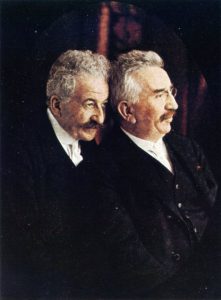
The Lumière Brothers
Considered by many the founding fathers of cinema, Auguste and Louis Lumière where two French brothers who invented the cinematograph.
Auguste Marie Louis Nicholas Lumière was born in 1862, and Louis Jean Lumière in 1864; both brothers are from Besançon, a city located next to the Swiss border. Since their early childhood, both Auguste and Louis and a very close contact with the world of photography, given the fact that their father, Antoine Lumière, was the owner of the Lumière Factory, where photographic plates were produced, and was also a photographer, having a small studio where he took portraits. This proximity with the art of photography and all the processes associated gave them a solid ground for the creation of the cinematograph, and for the study of the technique of moving images. Auguste and Louis Lumière studied Engineering, and along with their work in the factory inherited by their father, they were very dedicated to creating new inventions and to perfect the already existent devices and techniques, ending up with the invention of the cinematograph, which was a first major step to a series of changes in history and societies.
The cinematograph was a machine that allowed to capture, print and project images; it captured static images (frames) that were afterwards projected continuously, giving the illusion of movement.
The patent of the cinematograph was registered by the Lumière brothers on 13th February 1895, and they are considered to be the inventors of the device; however, there are records that state that the French inventor Léon Bouly was the real responsible for the creation of the first cinematograph, but since there is no evidence of any patent registration by him, it is impossible to conclude if this is a true fact.
The first public presentation of the cinematograph took place on 28th December in the same year it was invented, ate the Grand Café, in Paris. In this session, the Lumière brothers exhibited ten short movies that showed several moments of the daily life at the time, in black and white and without any sound. The first film presented was “La Sortie de l’Usine Lumière à Lyon” (“Workers Leaving the Lumière Factory in Lyon”), that showed the employees simply leaving the factory, as the title indicates. Another film that created a huge impact in this session was “L’Arrivée d’un train en gare de La Ciotat” (“Arrival of a Train at La Ciotat”), which simply showed a train arriving at a train station; there are even records that some spectators ran away of their seats, because they believed that a real train was coming and was going to run them over.
After this first exhibition, the Lumière brothers travel the world, showing their movies in the cinematograph in cities like London, New York or Mumbai; simultaneously, the brothers continued to record various moments of their daily lives, producing this way a lot of short movies that can be seen as the predecessors of modern documentaries.
Besides the cinematograph, the Lumière brothers are also responsible for the invention of the autochrome, which was the first process that allowed to produce photos in color, of the dry plate process of developing film, and of the “Maltese Cross” mechanism of projection.




